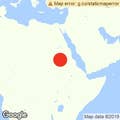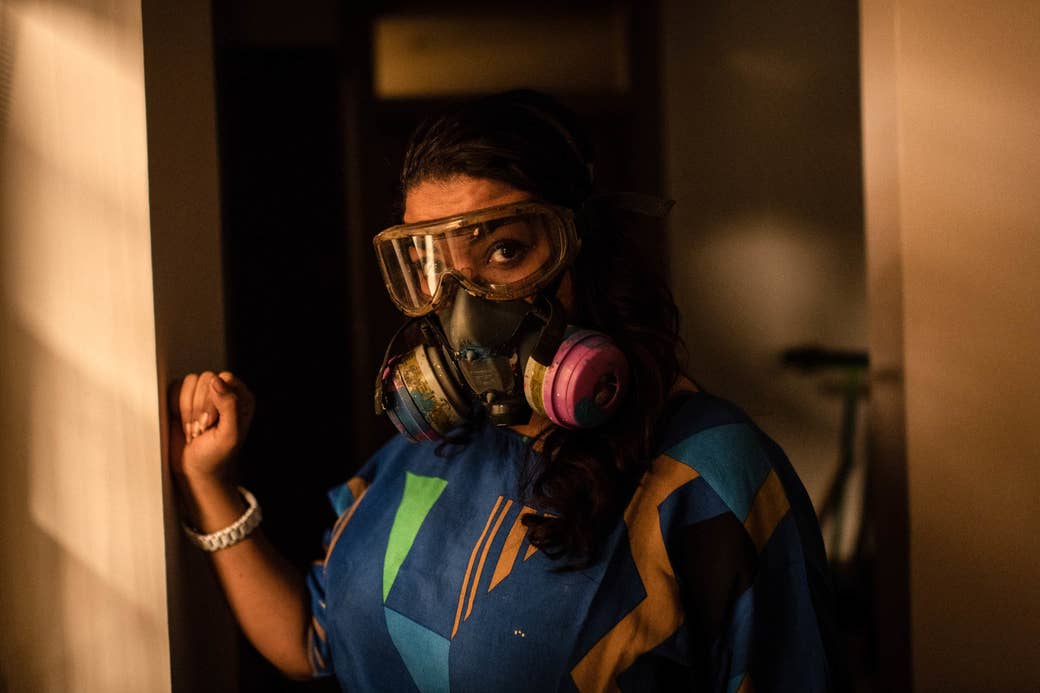
KHARTOUM, Sudan — Peering out of a tinted window from the backseat of the car as it crawled down an empty side street, the young graffiti artist’s eyes darted back and forth. She had to be sure the authorities weren’t already following her, that she would have enough time to jump out and paint the wall she’d chosen, and be back in the car before anyone alerted the armed soldiers stationed on every other corner. It’s a high-wire act.
But Assil Diab isn’t easily deterred. The 30-year-old street artist has a message she wants to get out. Diab’s graffiti, along with the work of several other local artists, has been screaming from walls and telephone poles all over the Sudanese capital of Khartoum for months now, ever since demonstrators staged a sit-in demanding civilian rule after the military ousted former president Omar al-Bashir.
When Diab took a phone call from a friend in the US, she reassured her that, despite the state’s violent crackdown on protests, she wasn’t scared. “I know everyone’s concerned, but it just got to the point where I decided I’m going to do what I came here to do,” Diab said after she hung up.
After all, she had a wall to paint.
When the protests began in April, Diab mostly painted portraits of people who had been killed by state security forces in the protests leading up to Bashir’s removal. Now she is covering the city in blue, the color that has come to symbolize the Sudanese uprising and has been popularized by the #BlueForSudan hashtag, which has gone viral around the world. But in Sudan, repeated internet shut downs over the last month have left most people with no idea of its meaning. Diab has resolved to change that, one wall at a time.
“They don’t know what’s happening, and I’m not connected to the internet [when I’m here],” said Diab, who grew up in Khartoum but travels back and forth between the capital and her home in Doha, Qatar. “But that’s why I need to paint.”
Diab is part of a group of artists behind the creative renaissance that’s emerged in Sudan since the sit-in began. The peaceful demonstration became known for the vibrant street art that took over walls and overpasses, and old revolutionary songs and poems sung by protesters of all ages.
But that ended suddenly on June 3 when the Rapid Support Forces (RSF), Sudan’s paramilitary troops, killed more than 100 people and injured at least 600 more. The government ordered an internet shutdown the same day. At least 40 dead bodies were recovered from the Nile River, and Sudanese medical staff have reported that dozens of men, women, and children were raped, all in a single week. The Transitional Military Council, established to lead the country during its three-year period between Bashir’s rule and the country’s next elections, has since admitted that it had ordered troops to break up the protest, which dealt a serious blow to the pro-democracy movement’s momentum. The country's military leadership and the civilian opposition coalition agreed to a power-sharing deal on Friday, after months of negotiation, but some celebrating in the streets remain wary after the still recent violence.
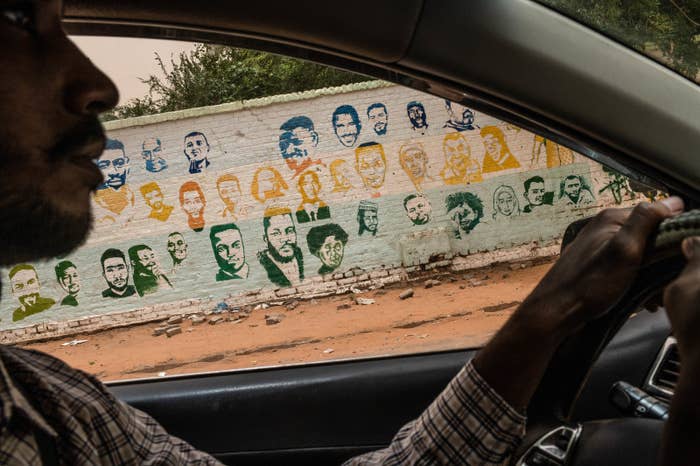
Online, the Sudanese diaspora mobilized to bring the rest of the world’s attention to the uprising taking place at home, especially after 26-year-old Mohamed Hashim Mattar, a British Sudanese engineer, was killed during the violent breakup of the sit-in. Mattar’s social media profile photo had been a solid shade of deep turquoise blue when he died, so to honor his life — and the lives of other people killed during the uprising — his friends changed their profile photos blue, too, and encouraged the rest of the world to do the same.
Within a few days, celebrities like Rihanna, Cardi B, Bas, and Sophia Bush followed suit. People outside the country changed their social feeds to a massive sea of blue, accompanied by the hashtags #BlueForMattar and #BlueForSudan, though there has been criticism of people exploiting the hashtag in order to increase their follower count.
Diab said she had met Mattar briefly at the airport in Khartoum after realizing they’d been on the same flight from Doha. She remembered him being so excited to join the sit-in that he went straight there after landing.
As a Sudanese diasporan who has the privilege of traveling between Khartoum and Doha with relative ease, Diab feels obliged to help bridge the gaps she’s seen inside and outside Sudan: both between Sudanese people and the rest of the world, and between online and offline activism. “It’s a revolution, and we all need to stay connected,” she said. “So we took the idea of painting the walls blue from the internet, and are bringing it into the real world.”
Her project adds another phase to the typical real-life-to-hashtag cycle: Mattar’s death inspired the viral #BlueForSudan, and now the massive online movement — which was created both to honor his life and to draw the world’s attention to the anti-government protests — is being explained to the very people it is meant to support.

After Diab inspected the wall to make sure the surface was smooth and wouldn’t cause the paint to peel, the driver popped the trunk, revealing buckets of blue paint and some brushes. Using the car’s headlights to guide them, they dipped the roller brushes in paint and started covering the wall. A few of the kids joined in, offering to fill in the cracks with smaller brushes. As she painted, Diab glanced behind her at the sound of every sputtering tuk-tuk motor. Her art and activism have put her in danger with the RSF — which grew out of the Janjaweed militias accused of committing war crimes in Darfur — before, and she wanted to avoid them at all costs.
“They came to my house before, about 10 days ago,” she said with a laugh common to activists who’ve been repeatedly harassed by the authorities.
“They were banging on the door and ringing the doorbell at the same time, which is freaky, you know?” she said. “When I looked out, they had their guns aimed at the door and they were using terror tactics to intimidate me.”
Diab said that for her and the small group she works with, “safety is number one, especially now. If we’re out on a main street, it’s a bit hard for me to feel comfortable painting. My back is facing everything else, and these guys...,” she said, trailing off.
“All they have to do is raise their gun and shoot you. They’re not gonna ask who I am, or why I’m doing all of this.”
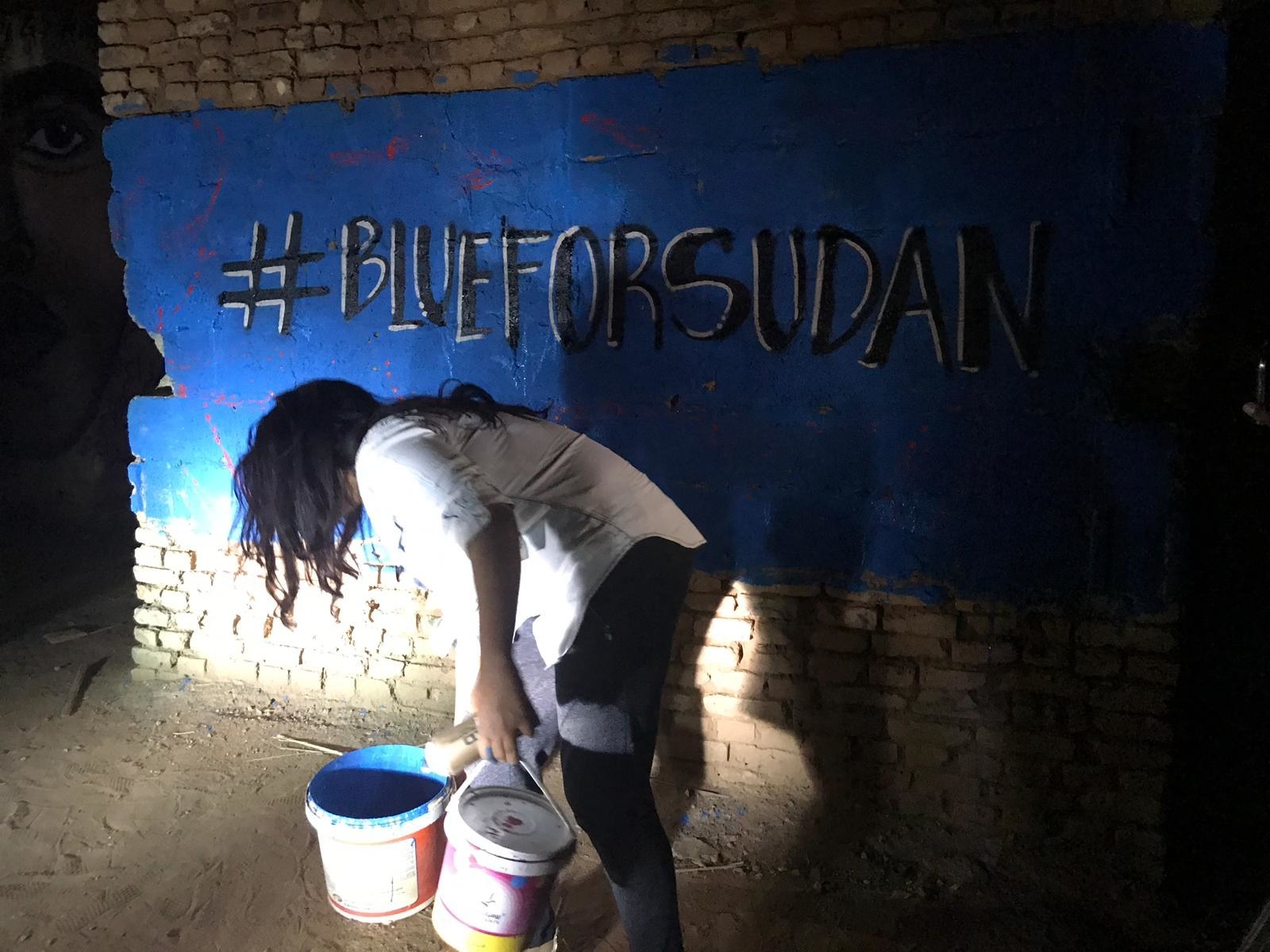
It meant that Diab couldn’t just stroll up to any random wall and start painting — she had to create a special process to ensure everyone’s safety.
Before painting martyrs’ portraits, either Diab or someone working with her reaches out to the family for permission. But if they’re painting a #BlueForSudan wall, she said, someone from her team “drives to the area an hour earlier and makes sure we have people from the community standing around, pretending to drink coffee, just looking out.” Everyone involved shares their phone numbers, so that if anyone sees the RSF approach, they can alert each other.
But painting the sides of houses, abandoned walls, and telephone poles in Mattar’s blue is only part of the mission. For Diab, the project means nothing if the communities don’t understand its significance, or how much those outside the country are supporting them. That’s why she and her small team of volunteers have also been talking to those who live in the areas they paint, telling them about the meaning of the particular shade (which Diab had custom-made by a painter in Khartoum to make sure it matched the blue that went viral) and what the hashtag means.
“As soon as you start explaining it ... people say things like, ‘Oh, my cousin has some internet. Maybe I should go there and check out this hashtag,’” Diab said. “Someone [from an older generation] actually wrote it down yesterday.”
The first wall of the night belonged to the home of Ha’zaa Hassan, who was 18 years old when he was killed June 3. She had previously painted Hassan’s portrait, and as soon as his mother, Ahlam, saw her approach, she quickly folded her into a tight hug. The greeting drew a small crowd of children and teens hanging out nearby. Then, with the urgency and precision of a surgeon performing an emergency procedure, Diab got to work.
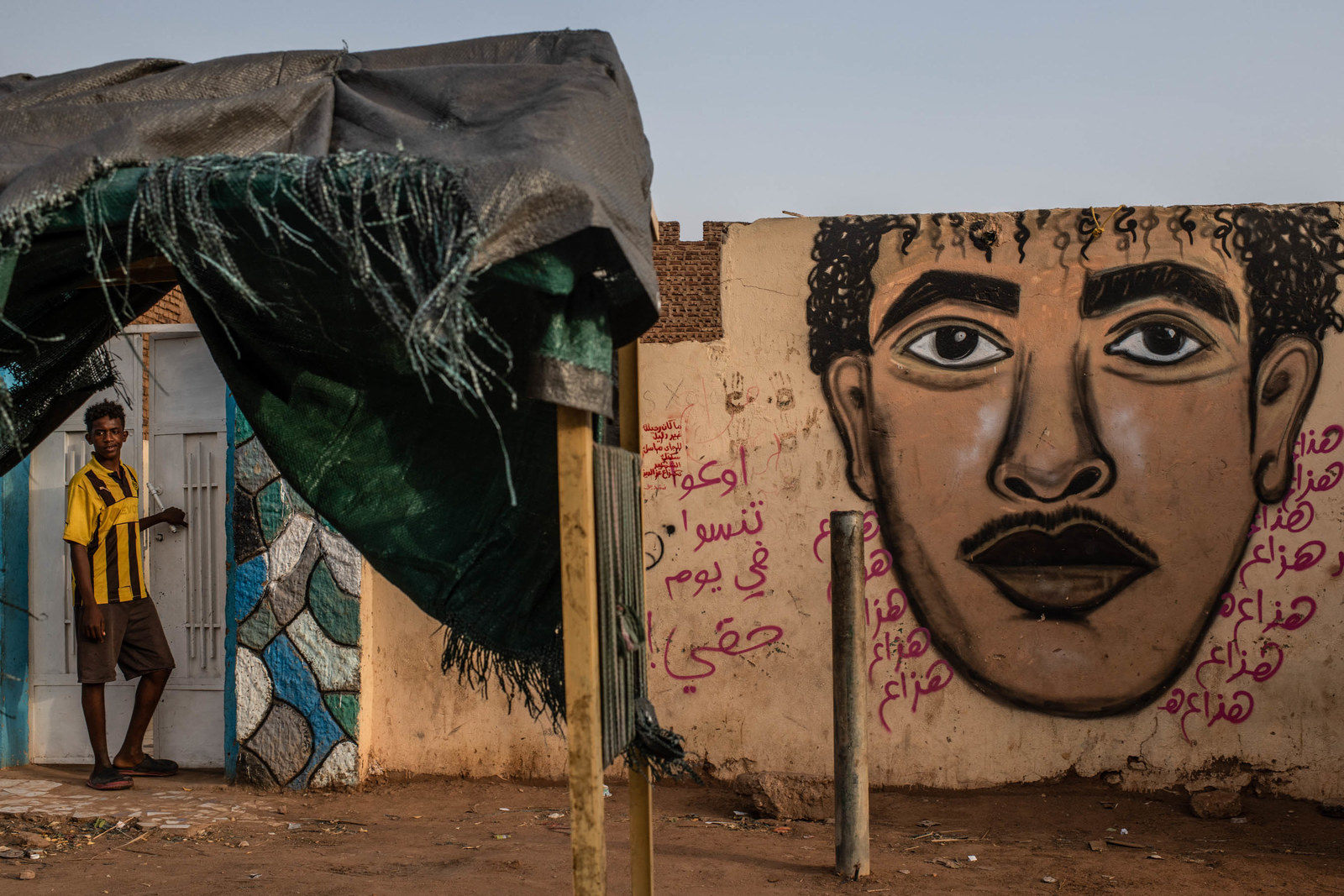
Diab’s first foray into graffiti art could not have been more different. In 2011, she was on a photography internship in Brooklyn when she saw graffiti for the first time, and quickly fell in love with it. When she returned to Doha, she took a position assisting eL Seed, a famous Tunisian graffiti artist.
“I picked up the know-how of spray painting really quickly,” she said, “to the point where [eL Seed] was like, ‘You know, you’re going somewhere with this.’ He really pushed me into it.”
When she wasn’t working on the project with him, Diab studied YouTube videos to learn new graffiti styles. “Now I know how to use spray paint better than I do a brush,” she said.
In 2013, she started a new job as a creative designer at Al Jazeera but decided to take a risk and quit after eight months to pursue graffiti full-time. She hasn’t looked back since.
But the joy of painting at home in Khartoum and making a living doing what she’s most passionate about still isn’t enough to protect Diab from the stereotypes faced by women who defy society’s expectations of them.
“Yesterday when we were painting, I could hear the kids nearby saying, ‘Look at how she’s dressed,’” said Diab, who was wearing a pair of fitted sweatpants and a long-sleeved button-down shirt. “That’s always a comment I hear. I’m not a hijabi, my hair is out, I’m wearing jeans.” Sometimes, she said, the kids will call her a prostitute, because they typically see her walking around at night.
And while those comments sting, especially because they come from children — “Maybe their dad is saying that about their sisters,” she wondered — Diab sees them as an opportunity to show that women are more than the clothes they wear. It doesn’t stop her from inviting those same kids to help her paint, either.
“I want people to get used to this, because it’s not [about] how I’m dressed, right? It’s what I’m doing, and if people could just focus on what I’m trying to do here, I can be put into use.”
Other times, the sexism is more subtle and comes from within the activist community. Diab recalled a time when a man asked her if he could join her crew and help spread her graffiti around Khartoum. When she brought him on, she emphasized the importance of following through on the tasks he was given, because they all depended on each other and one person’s mistake could compromise everyone’s safety.
But the new volunteer was unreliable, regularly missing phone calls and showing up late to meetings. Assil was frustrated. “If someone’s not doing what they should be doing and we all get in trouble, you basically just fucked us all up,” she said.
When she confronted him about it, though, he pushed back, saying that what they were doing wasn’t a business and that he was only there to support her, so how could she be so demanding?
“I was like, ‘This is not about me. This is about Sudan. And you came asking me to join,’” she remembered telling the man.
But it was more than that.
“I felt, deep down inside, that he had an issue with a woman telling him what to do,” she said. “I mean, if you’re a revolutionary and you're going out in the street protesting against the government who thinks the same way you're thinking right now? That makes you a hypocrite, because what is it that you want to change about Sudan if you don't want that change to be a woman also having equal rights as you?”
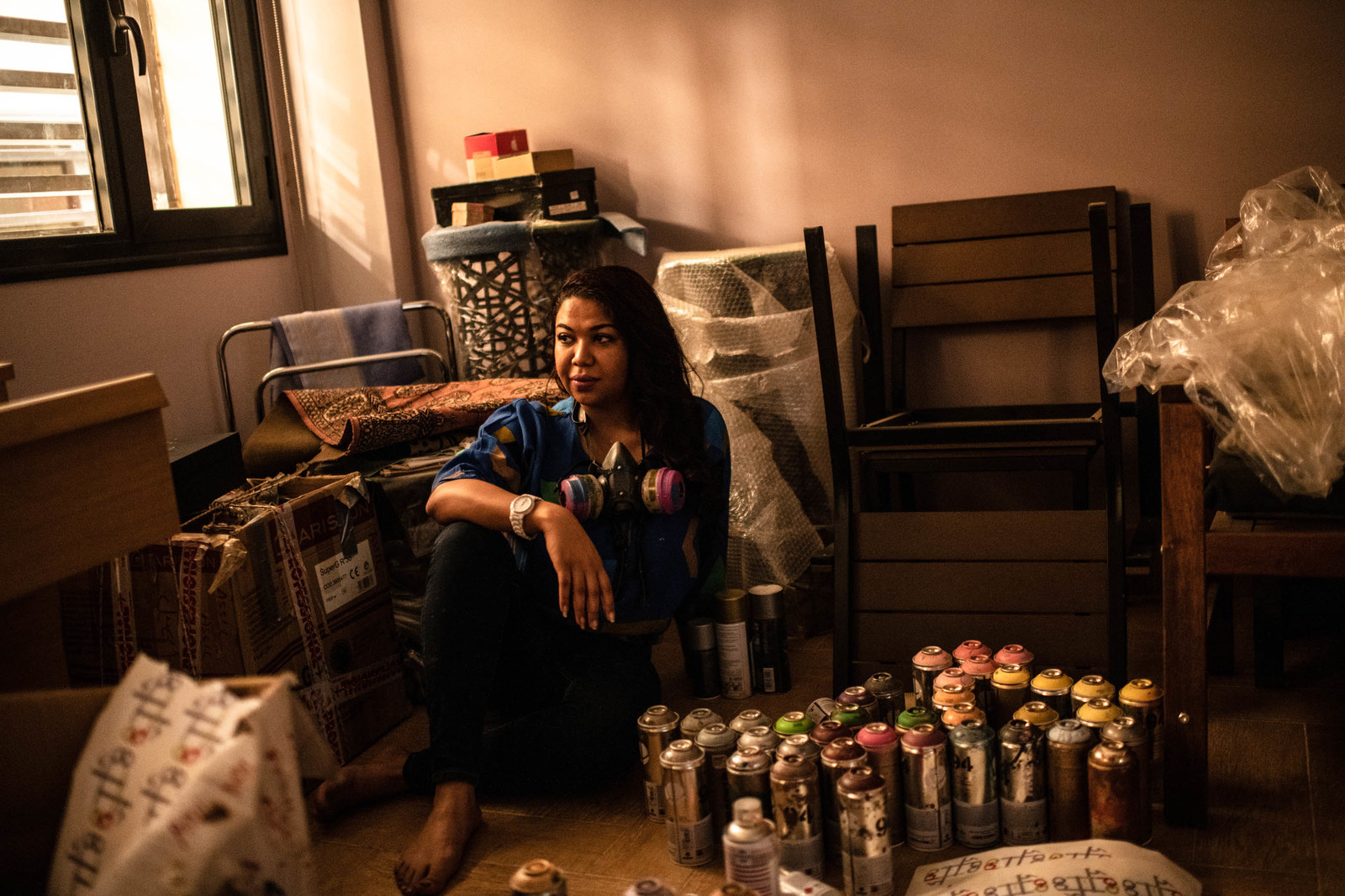
Within 15 minutes, Diab has finished the blue wall near Hazzah’s house. She’d spray-painted “#BlueForSudan” in black-and-white letters that gave the text a three-dimensional effect and framed it with a prayer to Hazzah in Arabic, which gained a huge round of applause from the kids who’d gathered to watch her. (They didn’t quite understand the English hashtag, until she broke it down for them in Arabic.) The final touches to her #BlueForSudan wall were splatters of red paint around the lettering, to symbolize the blood of those who were killed on June 3.
Some of the kids rushed to bring cold bottles of water to Diab and her friends before they left. She had returned the paint buckets to the trunk just as quickly as she’d brought them out, and was already scheming with her team about the next wall to paint.
And then they were off into the night.

